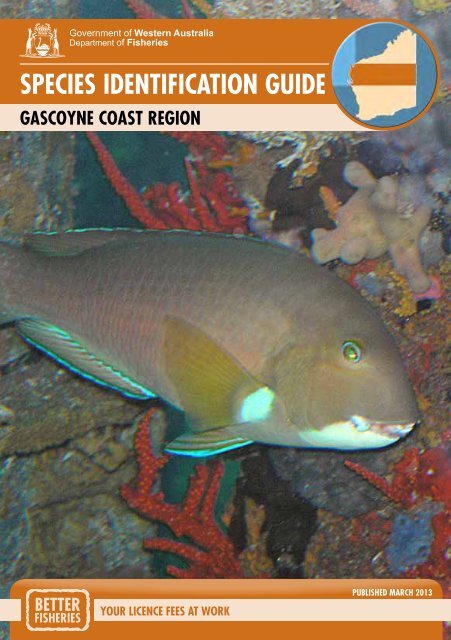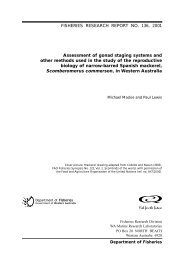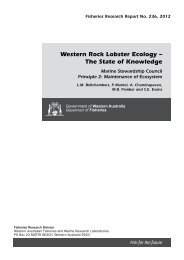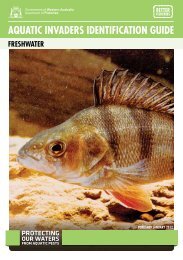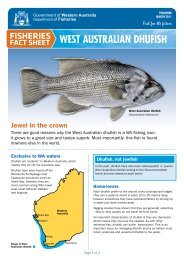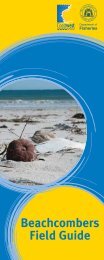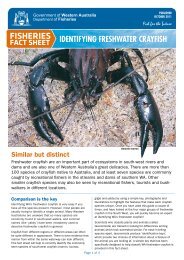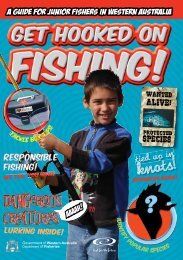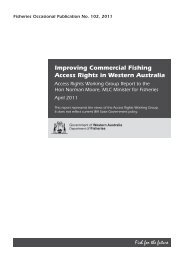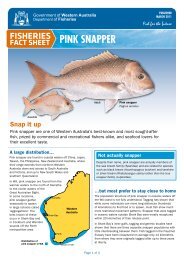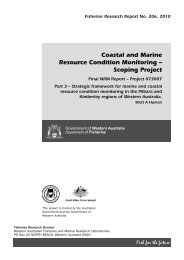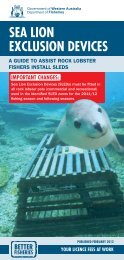Species Identification Guide - Gascoyne Coast Region
Species Identification Guide - Gascoyne Coast Region
Species Identification Guide - Gascoyne Coast Region
Create successful ePaper yourself
Turn your PDF publications into a flip-book with our unique Google optimized e-Paper software.
SPECIES IDENTIFICATION GUIDE<br />
GASCOYNE COAST REGION<br />
YOUR LICENCE FEES AT wORk<br />
PUBLISHED MARCH 2013
Photo: Tourism Western Australia<br />
ABOUT THIS GUIDE<br />
western Australia’s marine environment is divided into<br />
‘bioregions’ (biological regions).<br />
The <strong>Gascoyne</strong> <strong>Coast</strong> Bioregion runs from the Zuytdorp Cliffs,<br />
north of Kalbarri, to the Ashburton River, south of Onslow.<br />
The mix of tropical and temperate conditions in this region is<br />
reflected in the fish species found. To the north, near Exmouth,<br />
tropical species such as emperors and mackerel dominate.<br />
Farther south, there are temperate species such as western<br />
rock lobster, tailor, snapper (pink snapper) and mulloway.<br />
The region contains about 100 species of fish caught by<br />
recreational fishers. This guide provides a brief overview of<br />
some of the most sought-after species.<br />
Fishing rules are contained in a separate guide.<br />
Ningaloo and Shark Bay<br />
An array of aquatic life and natural wonders has made the<br />
Shark Bay World Heritage Area and Ningaloo Marine Park<br />
world-famous, attracting thousands of tourists and fishers<br />
each year.<br />
The protected waters of Shark Bay sustain extensive seagrass<br />
beds – key nursery areas for fish, prawns and scallops.<br />
2 INTRODUCTION
<strong>Gascoyne</strong><br />
<strong>Coast</strong><br />
27°S<br />
West<br />
<strong>Coast</strong><br />
Black Point<br />
114° 50' E<br />
Exmouth<br />
Carnarvon<br />
North <strong>Coast</strong><br />
(Pilbara/Kimberley)<br />
Port Hedland<br />
Karratha<br />
Onslow<br />
Denham<br />
Kalbarri<br />
Geraldton<br />
115°30' E<br />
WESTERN AUSTRALIA’S MARINE BIOREGIONS<br />
Ashburton River<br />
Perth<br />
Augusta<br />
Albany<br />
Esperance<br />
Broome<br />
21°46' S<br />
South <strong>Coast</strong><br />
Kununurra<br />
Eucla<br />
INTRODUCTION<br />
3
Snapper is popular with fishers. There are three separate stocks<br />
of snapper in Shark Bay’s inner gulfs, plus a separate oceanic<br />
population. These stocks don’t interbreed so are vulnerable to<br />
overfishing. Accordingly, special fishing rules apply.<br />
The warmer waters around the Ningaloo Marine Park support a<br />
diversity of marine life associated with its coral reef systems.<br />
Ningaloo Reef, 260km in length, is Australia’s largest fringing<br />
coral reef system. The Ningaloo Marine Park provides high-quality<br />
fishing for species such as spangled emperor, Spanish mackerel<br />
and coral trout.<br />
Exmouth Gulf has an extensive mangrove system, giving<br />
fishers the chance to target creek species such as mangrove<br />
jack and mud crabs.<br />
Categories<br />
In this guide fish are categorised according to their aquatic<br />
environment (see diagram below).<br />
200 mile Economic Exclusion Zone<br />
The boundary of WA’s legal control<br />
of marine resources<br />
PELAGIC<br />
4 FISH IDENTIFICATION<br />
DEMERSAL<br />
20m<br />
NEARSHORE<br />
ESTUARINE<br />
FRESHWATER<br />
• Demersal fish generally live on or near the ocean floor, often<br />
at depths of more than 20 metres.<br />
• Pelagic fish normally inhabit the surface or the middle depths<br />
of the ocean.<br />
• Nearshore and estuarine fish typically live in the estuary<br />
reaches of rivers and/or in the ocean in depths of water up<br />
to 20 metres.<br />
Note: Fish can be found outside environments covered by their<br />
category. For example, a demersal fish could be caught in a<br />
nearshore area.
DEMERSAL<br />
Baldchin groper<br />
Choerodon rubescens<br />
Habitat: Coral reefs and rock area.<br />
Grows to: About 70cm and 7kg.<br />
Reproduction: Matures as female at<br />
about three to four years and 27cm.<br />
Changes sex to male at about 10 to 12 years<br />
and 48 to 55cm. Features: Abruptly pale white chin,<br />
blunt snout with short head and eyes set well above mouth.<br />
Blackspot tuskfish<br />
Choerodon schoenleinii<br />
Habitat: Over seagrass beds and reefs.<br />
Grows to: About 80cm and 10kg.<br />
Reproduction: Matures as female<br />
at about 25cm and three years.<br />
Changes sex to male at about<br />
56cm and 10 years.<br />
Life span: At least 16 years.<br />
Features: Black spot at base of dorsal fin.<br />
Grass emperor (bluelined<br />
emperor, black snapper)<br />
Lethrinus laticaudis<br />
Habitat: Juveniles are commonly<br />
found over inshore seagrass beds.<br />
Larger fish migrate to coastal reefs.<br />
Grows to: About 80cm and 6kg.<br />
Reproduction: Matures as female at<br />
about 32cm then changes sex to male at<br />
about 38 to 44cm. Features: Dark streaks on each<br />
scale and short blue lines connecting the eyes.<br />
Bluespotted emperor<br />
Lethrinus sp.<br />
Habitat: Coral reefs and lagoons,<br />
hard sandy seabed away from reefs.<br />
Grows to: About 60cm and 3kg.<br />
Features: Blue cheek spots, brown<br />
streak from the eye to the jaw.<br />
FISH IDENTIFICATION<br />
5
Longnose emperor<br />
Lethrinus olivaceus<br />
Habitat: Coral and rocky inshore reefs.<br />
Grows to: About 100cm and 10kg.<br />
Features: Relatively slender body and long pointed<br />
snout. Dull greenish or olive colour with no<br />
distinctive markings.<br />
Spangled emperor<br />
Lethrinus nebulosus<br />
Habitat: <strong>Coast</strong>al reefs over sand.<br />
Grows to: About 80cm and 8kg.<br />
Reproduction: Matures at about 40<br />
to 45cm and four to five years old.<br />
Life span: At least 27 years.<br />
Features: Blue bars on cheek.<br />
Redthroat emperor (sweetlip emperor)<br />
Lethrinus miniatus<br />
Habitat: Coral/rocky reefs, forages widely<br />
over sand at night. Grows to: About 90cm<br />
and 9kg. Reproduction: Matures at<br />
about 40cm and six to seven years old.<br />
Changes sex from female to male.<br />
Life span: At least 22 years.<br />
Features: Red fins, mouth and red around eyes.<br />
Yellowtail emperor<br />
Lethrinus atkinsoni<br />
Habitat: Coral reefs, lagoons, seagrass.<br />
Grows to: About 45cm and 2kg.<br />
Features: Reddish fins and yellow-orange<br />
tail with red margins. Yellow around eye<br />
and red at corner of mouth.<br />
Chinamanfish<br />
Symphorus nematophorus<br />
Habitat: Inshore coral reefs and<br />
deeper offshore areas to at least 50m.<br />
Grows to: About 100cm and 18kg.<br />
Life span: At least 30 years.<br />
Features: Juveniles have elongated<br />
filaments on rear part of dorsal fin.<br />
6 FISH IDENTIFICATION
Barcheek coral trout<br />
Plectropomus maculatus<br />
Habitat: Inshore coastal reefs.<br />
Grows to: About 100cm and 25kg.<br />
Reproduction: Matures at about<br />
54cm and two years old. Changes sex from<br />
female to male. Life span: At least 12 years.<br />
Features: Solid-coloured pectoral fin, often<br />
misidentified as common coral trout.<br />
Common coral trout<br />
Plectropomus leopardus<br />
Habitat: Coral reefs.<br />
Grows to: About 80cm and 9kg.<br />
Features: Numerous, small blue spots<br />
on body, clear pectoral fin, colour varies from<br />
bright red to dark reddish-brown. Often misidentified<br />
as barcheek coral trout.<br />
Yellowedge coronation trout<br />
Variola louti<br />
Habitat: Inshore coral reefs and<br />
deeper offshore reefs to 100m.<br />
Grows to: About 83cm and 12kg.<br />
Features: Distinct half-moon tail.<br />
Goldband snapper (goldband jobfish)<br />
Pristipomoides multidens<br />
Habitat: Inhabits offshore reefs in<br />
deepwater, hard-bottom areas.<br />
Grows to: About 90cm and over 6kg.<br />
Life span: Up to 30 years.<br />
Features: Body is yellowish to rosy,<br />
particularly above the lateral line. There<br />
are two to three distinct yellow-gold bands with blue<br />
margins radiating over the snout below the eye.<br />
Goldspotted rockcod (estuary cod)<br />
Epinephelus coioides<br />
Habitat: Juveniles found in estuaries and<br />
among mangroves. Mature adults migrate<br />
to nearshore and offshore reefs.<br />
Grows to: About 120cm and 30kg.<br />
Reproduction: Matures as female at about 57cm<br />
and three to four years old. Changes sex to male at about<br />
55 to 75cm and five years old. Life span: At least 22 years.<br />
FISH IDENTIFICATION<br />
7
Rankin cod<br />
Epinephelus multinotatus<br />
Habitat: Juveniles are found in inshore<br />
coral reefs. Adults migrate to deeper<br />
offshore reefs and trawling grounds<br />
when mature.<br />
Grows to: About 100cm and 9kg.<br />
Reproduction: Matures at about 41cm. Changes<br />
sex from female to male.<br />
Life span: At least 22 years.<br />
Frypan bream<br />
(long-spined snapper, pan snapper)<br />
Argyrops spinifer<br />
Habitat: <strong>Coast</strong>al and deeper waters.<br />
Grows to: About 50cm and 2kg.<br />
Features: Elongated dorsal spines.<br />
Moses’ snapper (Moses’ perch)<br />
Lutjanus russellii<br />
Habitat: Estuaries, bays, and coastal<br />
and offshore reefs.<br />
Grows to: About 50cm and 2kg.<br />
Reproduction: Matures at about 29cm.<br />
Life span: At least 21 years.<br />
Features: Reddish colouration and black spot<br />
(sometimes faint) on back.<br />
Saddletail snapper<br />
(saddle-tailed seaperch)<br />
Lutjanus malabaricus<br />
Habitat: <strong>Coast</strong>al and offshore<br />
reefs and trawling grounds.<br />
Grows to: About 100cm and 8kg.<br />
Life span: At least 32 years.<br />
Features: Has a larger head and mouth than the<br />
crimson snapper, with which it can be confused.<br />
Robinson’s seabream<br />
Gymnocranius grandoculus<br />
Habitat: Deep offshore reefs and<br />
trawl grounds.<br />
Grows to: About 80cm and 5kg.<br />
Features: Wavy blue lines on cheek and snout.<br />
8 FISH IDENTIFICATION<br />
Juvenile
Stripey snapper<br />
(stripey seaperch, Spanish flag)<br />
Lutjanus carponotatus<br />
Habitat: Forms schools near inshore<br />
coral reefs and on soft seabeds to 80m.<br />
Grows to: About 50cm and 2kg.<br />
Reproduction: Matures at about 24cm.<br />
Life span: At least 20 years.<br />
Features: Sides of body are yellow or blue-grey<br />
with orange or yellow stripes.<br />
Snapper (pink snapper)<br />
Pagrus auratus<br />
Habitat: Reefs, large bays or on the<br />
continental shelf.<br />
Grows to: Over 100cm and 10kg.<br />
Reproduction: Matures at about 40cm<br />
and four to five years old.<br />
Life span: At least 30 years.<br />
Features: Top, tail and side fins are pink,<br />
and the bottom fins range from pale pink to creamy<br />
white. Bright blue spots on upper part of body.<br />
Red emperor<br />
Lutjanus sebae<br />
Habitat: Juveniles inhabit nearshore<br />
turbid waters to offshore reefs. Mature<br />
adults migrate to deeper offshore coral<br />
reefs and adjacent sand and rubble bottoms.<br />
Grows to: About 116cm and 33kg.<br />
Reproduction: Matures at about 50cm and three to four years.<br />
Life span: At least 34 years.<br />
Western rock lobster<br />
Panulirus cygnus<br />
Habitat: Inshore reefs to the continental shelf.<br />
Grows to: At least 17.5cm.<br />
Life span: At least 28 years.<br />
Reproduction: Females generally spawn at about<br />
six to seven years.<br />
Features: Shorter, less dense spines<br />
on upper carapace than the southern<br />
rock lobster, with which it can be confused.<br />
Juvenile<br />
FISH IDENTIFICATION<br />
9
PELAGIC<br />
Grey mackerel (broad-barred<br />
Spanish mackerel)<br />
Scomberomorus semifasciatus<br />
Habitat: <strong>Coast</strong>al seas near reefs.<br />
Grows to: About 125cm and 10kg.<br />
Reproduction: Matures at about 63cm and one to two years old.<br />
Life span: At least 12 years.<br />
Features: Dark bars down sides and black area at front of dorsal fin.<br />
Spanish mackerel (narrow-barred<br />
Spanish mackerel)<br />
Scomberomorus commerson<br />
Habitat: Offshore and coastal reefs.<br />
Grows to: About 240cm and 40kg.<br />
Reproduction: Matures at about 80cm<br />
and two years old.<br />
Life span: At least 22 years.<br />
Features: Banded pattern, elongated shape, fewer dorsal spines<br />
than its broad-barred relative.<br />
School mackerel<br />
(Queensland school)<br />
Scomberomorus queenslandicus<br />
Habitat: Inshore coastal waters.<br />
Grows to: About 130cm and 12kg.<br />
Reproduction: Matures at about 53 to 54cm<br />
and one to two years old.<br />
Features: Large dark spots on sides and black area at front of dorsal fin.<br />
Wahoo<br />
Acanthocybium solandri<br />
Habitat: Oceanic waters, well offshore.<br />
Grows to: About 250cm and 83kg.<br />
Reproduction: Matures at about one to two years old.<br />
Life span: At least six years.<br />
Features: Elongated shape, numerous spines in first dorsal fin.<br />
10 FISH IDENTIFICATION
Cobia<br />
Rachycentron canadum<br />
Habitat: <strong>Coast</strong>al waters.<br />
Grows to: 200cm and 68kg.<br />
Reproduction: Matures at 50 to 60cm<br />
and two to three years old.<br />
Life span: At least 15 years.<br />
Features: White stripe on side.<br />
Mahi Mahi (dolphin fish)<br />
Coryphaena hippurus<br />
Habitat: Warm oceanic waters, often<br />
schooling around floating objects.<br />
Grows to: About 210cm and 40kg.<br />
Reproduction: Matures at about 40<br />
to 50cm and four to five months old.<br />
Life span: Short lived, up to four years.<br />
Features: Yellow sides with black spots,<br />
elongated body and humped head.<br />
Mackerel tuna<br />
Euthynnus affinis<br />
Habitat: Open waters close to<br />
the shoreline.<br />
Grows to: About 100cm and 14kg.<br />
Reproduction: Matures at about 50 to 60cm<br />
and three years old.<br />
Features: Dark blue colouring on shoulder and<br />
broken stripes on lower back.<br />
Longtail tuna<br />
(northern bluefin tuna)<br />
Thunnus tonggol<br />
Habitat: Inshore and ocean waters.<br />
Grows to: About 150cm and 36kg.<br />
Features: Short pectoral fins and slender body shape.<br />
Yellowfin tuna<br />
Thunnus albacares<br />
Habitat: Oceanic waters generally<br />
well offshore. Seasonally in<br />
temperate waters.<br />
Grows to: About 210cm and 176kg.<br />
Reproduction: Matures at about 100 cm and<br />
two to three years. Life span: Around 10 years.<br />
Features: Elongated yellow dorsal and anal fins.<br />
FISH IDENTIFICATION<br />
11
NEARSHORE<br />
Blue swimmer crab<br />
Portunus armatus (formerly Portunus pelagicus)<br />
Habitat: Bays, estuaries, muddy or sandy<br />
bottoms, intertidal areas to 60m deep.<br />
Grows to: About 20cm carapace width, 80cm<br />
claw span and 1kg. Reproduction: Matures at<br />
8 to 9cm carapace width. Life span: Up to three<br />
to four years. Features: Mottled blue in males and<br />
mottled brown in females, broad carapace, long claws.<br />
Green mud crab (giant mud crab)<br />
Scylla serrata<br />
Habitat: Muddy bottoms among mangroves,<br />
in sheltered estuaries and tidal flats.<br />
Grows to: About 30cm carapace width and 2.5kg.<br />
Reproduction: Matures at about 11cm carapace<br />
width. Life span: Up to four to five years.<br />
Features: A pair of double spines situated behind<br />
each claw and another pair on each wrist.<br />
Chinaman rockcod (Charlie Court cod)<br />
Epinephelus rivulatus<br />
Habitat: Inshore coral and rock reefs,<br />
small coral heads or among weed.<br />
Grows to: About 35cm and 1kg.<br />
Reproduction: Changes sex from female to male.<br />
Features: Oblique brown/reddish bars on sides, white<br />
blotches on head, large mouth.<br />
Common dart<br />
Trachinotus botla<br />
Habitat: Sheltered bays and estuaries to<br />
surf beaches. Grows to: About 75cm and 3.5kg.<br />
Features: Small embedded scales, short pectoral<br />
fins, deep angular body.<br />
Longtom<br />
Family Belonidae<br />
Habitat: <strong>Coast</strong>al waters, sometimes fresh water, to well offshore<br />
in the open sea. Grows to: About 150cm and 6.5kg.<br />
Features: Long slender body, jaws extended into a bill, sharp teeth.<br />
12 FISH IDENTIFICATION
Giant trevally<br />
Caranx ignobilis<br />
Habitat: <strong>Coast</strong>al waters and offshore<br />
waters near reefs.<br />
Grows to: About 170cm and 80kg.<br />
Reproduction: Matures at about 95 to<br />
96cm and five years old.<br />
Features: Steep forehead, silvery dusky colour.<br />
Golden trevally<br />
Gnathanodon speciosus<br />
Habitat: <strong>Coast</strong>al waters and offshore<br />
waters near reefs.<br />
Grows to: About 120cm and 15kg.<br />
Features: Large fleshy lips, no discernible<br />
teeth and golden belly with black spots.<br />
Turrum (goldspotted trevally)<br />
Carangoides fulvoguttatus<br />
Habitat: <strong>Coast</strong>al waters.<br />
Grows to: About 130cm and 12kg.<br />
Features: Elongated shape with<br />
gold/brassy spots on side and back.<br />
Black Jewfish (northern mulloway)<br />
Protonibea diacanthus<br />
Habitat: Found in tidal rivers, estuaries and<br />
coastal waters over muddy bottom.<br />
Grows to: About 150cm and 20kg.<br />
Reproduction: Matures at about 75cm<br />
and three years old.<br />
Features: Large scales, needle-like teeth and<br />
silvery-bronze in colour.<br />
Mulloway Argyrosomus japonicus –<br />
also known as Argyrosomus hololepidotus<br />
Habitat: <strong>Coast</strong>al embayments and<br />
estuaries, off beaches and inshore reefs.<br />
Grows to: About 200cm and 74kg.<br />
Reproduction: Matures at about 90cm and six years old.<br />
Life span: Around 30 years.<br />
Features: Silver/bronze sides, long dorsal fin and ‘spade tail’.<br />
FISH IDENTIFICATION<br />
13
Mangrove jack<br />
Lutjanus argentimaculatus<br />
Habitat: Juveniles inhabit mangrove<br />
estuaries and tidal rivers. Mature adults<br />
migrate to sheltered inshore coral reefs<br />
and offshore trawling grounds.<br />
Grows to: About 150cm and 12kg.<br />
Reproduction: Matures at about 54 to 55cm and five<br />
to six years old. Life span: At least 52 years.<br />
Features: Tall dorsal fin, no stripes on side, no black on fins.<br />
Silver toadfish (north-west blowfish)<br />
Lagocephalus sceleratus<br />
Habitat: <strong>Coast</strong>al waters.<br />
Grows to: About 88cm and 6.5kg.<br />
Features: Distinct silver stripe on side,<br />
pronounced incisor teeth. Can give a<br />
serious bite. Flesh is poisonous.<br />
Giant queenfish<br />
Scomberoides commersonnianus<br />
Habitat: Tropical waters over the<br />
continental shelf, often in very<br />
shallow water.<br />
Grows to: About 120cm and 16kg.<br />
Reproduction: Matures at about 63cm.<br />
Features: Leathery skin with needle-like scales, sides have dark blotches.<br />
Oriental bonito<br />
Sarda orientalis<br />
Habitat: <strong>Coast</strong>al seas.<br />
Grows to: About 100cm and 10kg.<br />
Features: Distinguished by narrow horizontal<br />
stripes on upper part of body.<br />
Sea mullet<br />
Mugil cephalus<br />
Habitat: Abundant in estuaries and<br />
coastal bays. Mature fish migrate to<br />
open sea to spawn.<br />
Grows to: About 80cm and 4kg.<br />
Reproduction: Matures at about 30cm<br />
and three to four years. Life span: Around 16 years.<br />
Features: Large gelatinous eyelid and bluish spot on pectoral fin base.<br />
14 FISH IDENTIFICATION<br />
POISONOUS
Tailor<br />
Pomatomus saltatrix<br />
Habitat: Beaches, inshore reefs, estuaries.<br />
Grows to: About 120cm and 14kg.<br />
Reproduction: Matures at about 35cm and two<br />
to three years old. Life span: Around nine years.<br />
Features: Prominent lower jaw, silver, elongated and compressed body.<br />
Tarwhine (silver bream)<br />
Rhabdosargus sarba<br />
Habitat: <strong>Coast</strong>al marine, estuaries and<br />
offshore reefs to 35m deep.<br />
Grows to: About 50cm and 2.5kg.<br />
Reproduction: Matures at about 17cm to<br />
21cm and two to three years.<br />
Features: Silvery with yellow lines matching scale<br />
rows, anal and pelvic fins vary from yellow to orange.<br />
Western yellowfin bream<br />
Acanthopagrus latus<br />
Habitat: <strong>Coast</strong>al reefs, estuaries and inshore<br />
reefs to 35m.<br />
Grows to: About 50cm and 1.5kg.<br />
Reproduction: Matures as male at about<br />
24cm and two to three years old, then changes<br />
sex to female.<br />
Life span: At least 24 years.<br />
Features: Has yellow fins.<br />
Western school whiting<br />
Sillago vittata<br />
Habitat: Inshore marine.<br />
Grows to: About 30cm and 0.2kg.<br />
Reproduction: Matures at about 13 to 16cm.<br />
Features: Distinctive dark blotch at base of pectoral fin.<br />
Yellowfin whiting<br />
Sillago schomburgkii<br />
Habitat: Shallow sandy areas near<br />
estuary mouths and inshore waters.<br />
Grows to: About 42cm and 0.7kg.<br />
Reproduction: Matures at about 18 to 20cm<br />
and two years.<br />
Life span: Up to around 12 years.<br />
Features: Yellow pelvic and anal fins, sides plain and silvery, pointed snout.<br />
FISH IDENTIFICATION<br />
15
Before you go fishing, let someone know<br />
where you are going and contact them if<br />
your plans change. Always let them know<br />
when you return.<br />
The information in this guide is current<br />
at the date of printing, but may change.<br />
A separate guide on fishing rules is<br />
available.<br />
For the most up-to-date information on<br />
fishing visit the Department of Fisheries<br />
website or contact us.<br />
Further information<br />
HEad OFFiCE<br />
3rd Floor, The Atrium,<br />
168 – 170 St Georges Terrace,<br />
Perth WA 6000<br />
T: (08) 9482 7333<br />
ABN: 55 689 794 771<br />
GaSCOYNE REGiONaL OFFiCE &<br />
CaRNaRvON diSTRiCT OFFiCE<br />
59 Olivia Tce, Carnarvon WA 6701<br />
T: (08) 9941 1185 F: (08) 9941 1951<br />
dENHaM diSTRiCT OFFiCE<br />
63 Knight Tce, Denham WA 6537<br />
T: (08) 9948 1210 F: (08) 9948 1154<br />
EXMOUTH diSTRiCT OFFiCE<br />
Cnr Payne & Riggs St, Exmouth WA 6707<br />
T: (08) 9949 2755 F: (08) 9949 1558<br />
www.fish.wa.gov.au<br />
It’s f shy, fascinating and fun!<br />
Come along to learn more about WA’s<br />
oceans and rivers through vibrant<br />
displays and interactive exhibits.<br />
39 Northside Drive, Hillarys Boat Harbour,<br />
Hillarys, Western Australia 6025<br />
E: nmdc@fish.wa.gov.au<br />
W: www.nmdc.com.au T: (08) 9203 0339<br />
Naturaliste Marine<br />
Discovery Centre<br />
Recycle – please return unwanted brochures or pass on to a friend.<br />
RF424-06 MARCH 2013 Illustrations © R.Swainston/www.anima.net.au Cover photo: Baldchin groper by Carina Gemignani


